|
|
|
|
Early Warning and Early Response, by Susanne Schmeidl and Howard Adelman (eds.)
Steven Livingston
Political Communication and International Affairs
The George Washington University
David Stephen
The NewsHour with Jim Lehrer
Denver Bureau
Introduction
Among the questions most frequently asked by scholars interested in media and international affairs are these:
In this chapter, we are most concerned with American network television news of Rwanda in the 1990s, and international news more generally. We will present data that suggest the most salient feature of American network coverage of Rwanda in 1994 was the relative lack of attention paid to the massacre of hundreds of thousands of people. Furthermore, we will present additional data suggesting that with a handful of important exceptions this same inattention carried over to the eventful years following the 1994 massacres.
But beyond these data we are interested in offering a context for evaluating how exceptional coverage of Rwanda has been in the overall scheme of television news coverage of international affairs. Put otherwise, we want to speak to whether Rwanda was somehow an exception to larger trends found in American network coverage of international affairs. Only in that context can we offer an assessment of likely future trends. To accomplish this we offer an empirical assessment of international news content on American network television. It is quite exhaustive and extends the research already conducted by media scholars to more recent time periods. We will eventually argue that coverage of Rwanda in the 1990s reflected trends in American television coverage of international news. Specifically, television news has in some measure abandoned its commitment to coverage of international affairs.
We will first discuss coverage of Rwanda in 1994 and the years since the first wave of massacres. We will then turn to a broader gauge evaluation of American television news.
Rwanda Coverage in 1994
Relative to other events, the massacre of approximately one million persons in Rwanda in the spring of 1994 received limited attention on American network television news. Figure 1 tracks the aggregate attention devoted to five events or processes by ABC, CBS, and NBC for the months of April through August 1994 (Livingston and Eachus, forthcoming). 1
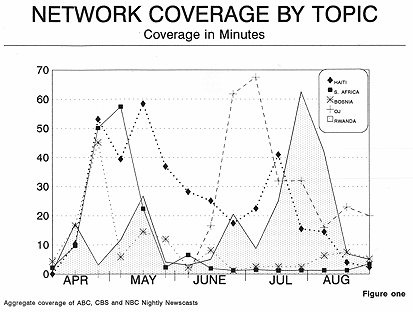
As an American invasion seemed imminent in, Haiti captured the lions share of the news early in the year. Competing for attention was Haiti was the election and subsequent inauguration of Nelson Mandela in South Africa. And throughout 1994, Bosnia was a constant but relatively low-key story.
The genocide in Rwanda occurred in April and May. In April, about twenty minutes of aggregate network news time that month was devoted to the genocide. In May, due in part to the presence of additional news crews in Africa for President Mandela’s inauguration, aggregate coverage temporarily spiked, reaching its highest point during the killing period. This is the high water mark for television coverage of the Rwandan genocide. It was not until later, when news crews were sent to places such as Goma, Zaire to cover the medical crisis wrought by disease in the Hutu refugee camps, that we saw the greatest devotion of network attention to events in Central Africa.
In the meantime, the murder of two people in Los Angeles and the plight of their alleged assailant, a former football player named O.J. Simpson, captured more media attention than any other event on American network news. What we might call “O.J. coverage” dwarfed coverage of Bosnia and the crisis in Haiti, and even outstripped coverage devoted to what was perhaps the most brutal and intense massacre of the twentieth century.
The relative attention given to different stories aside, with closer analysis we also see interesting patterns emerge within the Rwanda story. The first pattern concerns the type of news frame used to make sense of events. A news frame simply refers to the interpretive angle or framework of understanding assigned to events in the process of telling a story. Rwanda was in a sense two stories for the networks. The first news frame concerned the genocide in Rwanda. This is a political story of aggressors and victims, of political struggle at its bloodiest. The second more dominant frame was the medical story in the refugee camps. Here the frame offers a human interest story. The fight is against disease. Although it would be an overstatement to say politics is stripped out of this second frame, it is accurate to say politics is secondary to human interest.
We can see this in tracking the datelines during key months over the summer of 1994 (see figure 2). A substantial increase in network coverage coincides with the establishment of the large refugee camps in Goma and elsewhere. This trend is even more pronounced in CNN coverage (see figure 3). CNN covered the Hutu refugees in Goma while paying considerably less attention to the killing of Tutsi and moderate Hutu during the genocide.

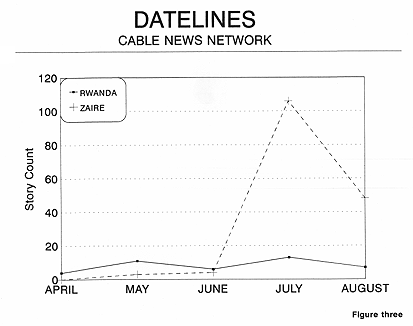
Why so much coverage given to the refugee camps but not the genocide? The refugee camps offered compelling stories for the networks and CNN for at least three reasons.
First, the story was logistically manageable and relatively safe. The United Nations/NGO community offered logistical support and security for the reporters covering the refugee camps. Goma was relatively safe to cover. One of the authors of this present study was with the Western press in Nairobi, Kenya at the time of the initial massacre in Rwanda. He watched daily as Terry Leonard of the Associated Press, Donatella Lorch of The New York Times, and others tried to find reasonably safe access to the killing fields in and around Kigali. Leonard was turned back repeatedly at the airport or stadium in Rwanda’s capital city. It was, without question, too dangerous. Those who criticize Western press coverage of the genocide should take a moment to consider the risks involved and whether they would have been any more willing to descend into the maelstrom of wholesale killing.
Secondly, the refugee camps offered a relatively easy story to tell. The complexities of Rwandan politics were difficult for the reporter to first understand, particularly for those new to the region, and difficult to tell. The limited time allotted a reporter on television news compounded the problem. Who are the Hutu? Who are the Tutsi? Why are they killing one another?
During the Cold War, distant and obscure conflicts could be made sense of with references to “the American-backed . . . and the Soviet-backed . . . ” In actuality, it is probably safe to assume that little of the world was actually explained by these phrases. 2 Yet they offered reporters a way of framing complex events for an audience often unable to find the countries involved on a map. Rwanda was mysterious and at least at first unfathomable. Who were the Hutu and why were they killing their Tutsi neighbors?
In the refugee camps, the story was simpler. The enemy was disease. Authorities, usually white and English speaking, served as authoritative sources offering apolitical assessments concerning mortality rates, food and water disbursement statistics, and refugee population counts. CBS even sent its medical affairs correspondent, rather than its foreign or war correspondents. Goma was a human interest story. The medical frame was easier. It offered a clearer demarcation of the situation. If viewers had difficulty keeping heroes and villains straight, something clearer emerged in the medical story. There were the victims — reinforced by a constant stream of video of the sick and the dying — and there were the heroes, the NGO doctors. This allowed the thornier issue of the Hutu and the Tutsi and what it all meant to be pushed to the background.
What kind of coverage was given to the crisis in Rwanda? Figure 4 tracks ABC News coverage of Rwanda–Zaire from January 1994 to December 1995. Two categories of news coverage are tracked: “hard” and “chat.” Hard news is the straight presentation of information. Although analysis and speculation is sometimes a part of hard television news, the primary objective is to convey information about what is happening in the world and what has happened in the last 24 hours. Hard news refers to programming on “World News Tonight with Peter Jennings” and ABC’s weekend evening news programming. Chat refers to the talk programs. There are more interviews of experts, of politicians and officials, and of other reporters. Just as hard news is not free of analysis and speculation, chat is not devoid of the attributes of a hard news program. “This Week With David Brinkley,” “Nightline,” and “20/20” are examples of chat news programming during the time period reviewed here.
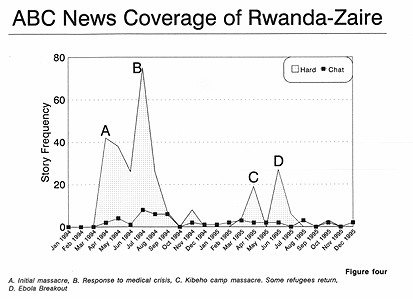
Three major episodes or events are noted in figure 4. Point ‘A’ is the beginning of the massacre. Point ‘B’ is the international response to the refugee camps. Point ‘C’ designates the Kibeho refugee camp massacre. On April 22, 1995, an estimated 2,000 Hutu refugees were killed and more than 600 wounded at the Kibeho refugee camp. The victims were either shot by Rwandan Army soldiers or trampled to death in the panic (Lorch April 24, 1995, p. 1).
Figure 5 tracks CNN coverage for the same period. Before comparing these two graphs it should be emphasized different frequency scales were used to accommodate the programming dimensions of CNN’s 24-hour news hole. Examples of hard news programming on CNN are “CNN Worldview,” “The World Today,” and “CNN World Report.” Chat programming includes “Crossfire,” “CNN Reliable Sources,” “CNN Presents,” and “CNN & Company.”
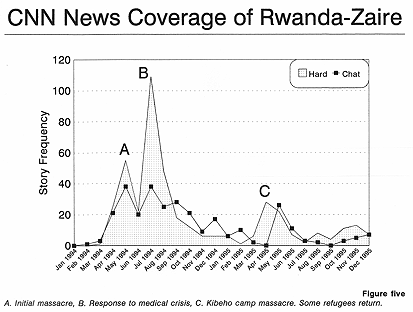
The requirements of a 24-hour news channel create more chat programs, not necessarily more hard news. “Chat,” it should be pointed out, is not necessarily unhealthy. Certainly in a democracy, chat programming such as CNN’s “Crossfire” can be illuminating. But what should be clear from these last two graphs and the other evidence is that CNN covered Rwanda no better than the traditional broadcast networks.
On the whole, American network television news failed to distinguish itself in covering Rwanda. Although the danger and conditions in Rwanda in April and May 1994 make part of this understandable, the inattention to the brewing conflict before it spilled over into a bloodbath is not. The story of Rwanda in 1994 was difficult for American journalists to tell because so few had paid attention to it in 1990, or in 1993, or any of the key years leading to the tragic events in 1994.
|
Table 1: ABC & CNN Coverage of Rwanda 1990–1994
|
|||||||||||||||||||||
The ABC story in 1991 mentioned Rwanda in passing in a story about possible Aids vaccine. The single 1992 mention of Rwanda on ABC was on “This Week With David Brinkley.” Sam Donaldson asked Patrick Buchanan if he was as upset by killings in Burundi as he was about the killings in Europe during the collapse of the Eastern Bloc. Buchanan’s response was interesting, if not ironic: “We’ve seen massacres in Burundi, for example, of hundreds of thousands of people, in Rwanda and other places, that get no coverage whatever. We tend to cover people like us in journalism and to concern ourselves with the fate of people like us” (“This Week With David Brinkley,” February 23, 1992).
The following year saw two stories: one about the conflict in Burundi and the other about Rwanda’s mountain gorillas and how they might be threatened by the political unrest in the region. And of course, 1994 saw the explosion in coverage.
CNN’s coverage was similar. There were no stories about Rwanda in 1990, despite the RPF offense that year. In October, the RPF attacked northern Rwanda from neighboring Uganda in an attempt to overthrow President Juvenal Habyarimana’s government in Rwanda. In 1991, one of the three stories mentioned Rwanda in passing in discussing Malaria. The second was a “Larry King Live” segment on mountain gorillas. The third was a repeat of the “Larry King Live” segment. In 1992, CNN did not offer a news story concerning Rwanda. The following year saw something of a bumper crop of stories with eleven. They concerned several reports that mentioned Rwanda only in passing, usually in connection with the gorillas. Gary Streiker’s September 10, 1993 report on the efforts to find regional stability is the clear exception to the reporting before the massacre. It stands as the best — in fact, the only sustained attention to the conflict in Rwanda before 1994.
In summary, American television coverage of Rwanda was episodic and ephemeral. When the networks did begin to cover the horrific events in 1994, the majority of the attention was devoted to the refugee camps and not to the events that led to the creation of the camps in the first place. As we pointed out, there are compelling reasons why journalists found it difficult to operate in Rwanda in April and May during the killing period. But nevertheless, the prominence of the medical story frame undermined the potential educational value, so to speak, of news from central Africa. In other words, rather than political stories that tried to untangle the politics of the region, we were offered an excess of human interest stories concerning the fight against disease in the camps.
How unusual was the pattern of network news inattention to Rwanda? How close to the mark was Pat Buchanan when he claimed that journalism tends to “cover people like us” and to be concerned with “the fate of people like us.” By “us,” of course, Buchanan meant persons of European extraction. In the next section we wish to offer a context for evaluating Rwanda coverage.
American Network News and International Affairs
To get a clearer sense of the Rwanda coverage requires that we place it in the larger context of international affairs content on American network news. For the most part, we will limit our analysis to the three traditional broadcast network evening news programs. We will find that coverage of Rwanda conforms to the general pattern of network news coverage of international affairs, particularly after the Cold War.
International News Content
Analysis of the international content in American television news programming has typically centered on three variables: proportionality, geographical focus, and theme. Proportionality asks how much of network news content is devoted to international news. Geographical focus, as the term suggests, is concerned with the geographical distribution of network news attention. Theme asks which categories of events or processes tend to capture the attention of network news.
In a series of seminal studies in the 1970s, James Larson established benchmark findings concerning these variables that have been used by others in more recent analysis. Larson (1982) concluded that network television news had by the 1970s expanded its role as an important “window on the world” for the American public, in some measure supplanting newspapers and magazines. 3 He found that on average, nightly news broadcasts between 1972 and 1979 contained seventeen news stories (p. 24). Of these, a little over six stories, or 37 percent of the total content, dealt with international events. Larson reported a similar proportion of international affairs news in a follow-up study published in 1984. 4 Nearly half of any given evening newscast was devoted to international affairs news (Larson 1984 p. 145).
Although the news paid attention to international events, most of the coverage focused on but a handful of places. More than 75 percent of all international news stories mentioned two or more nations, and 61 percent of the time one of those countries was the United States. This indicated that international news was defined in terms of American interests (1982 p. 28). The most frequently mentioned nations other than the United States — in descending order — were the USSR, Israel, Great Britain, Vietnam, and Iran. 5
Thematically, Larson (1984 p. 146) found that approximately 27 percent of the international affairs news dealt with crises, such as civil unrest, war, terrorism, coups, assassinations or disasters.
More recently, Pippa Norris (1995) conducted a longitudinal content analysis of ABC and CBS network news from 1973 – 1995. Each year’s sample included between 59 and 125 stories. 6 She divided the 23-years reviewed into three periods: the Cold War period (1973–1988), the Transitional period (1989–1991), and the Post-Cold War period (1992–1995).
Norris found a precipitous decline in network attention to international affairs news over these three periods. The proportion of each newscast devoted to international coverage fell from 45 percent in 1973 to 27 percent in 1995. Measured in minutes, international news fell from an average of about ten minutes per night in 1973 to five minutes per night in 1995.
Not surprisingly, geographic focus during the Cold War Period clearly centered on the USSR. During the Transitional Period, attention turned to Central and Eastern Europe. The Post-Cold War Period has introduced a more scattered pattern to international news attention.
Though Norris found that war and unrest has always been the most covered theme in news stories, it has risen to comprise at least 57 percent of the newscasts from 1989 to 1995. The dominant theme of international news in the Post-Cold War period is bloodshed. In that regard, Rwanda played an important role in defining post-Cold War news content.
In another important study, Stephan Hess analyzed content of television newscasts from 1988 – 1992. 7 He found that 50 percent of American networks’ international stories were about U.S. citizens or U.S. foreign policy. Additionally, nearly 50 percent of foreign dateline stories mentioned the U.S. Another 7 percent of international stories covered the overseas trips of U.S. presidents, vice presidents, and secretaries of state or defense. “International news” comes with a distinctly American accent.
Beyond the focus on the United States in foreign contexts, Hess found that the news tends to be narrowly focused on a handful of countries and regions. Twenty-one countries accounted for 79 percent of the foreign dateline stories on the newscasts from 1988 to 1992 (p. 31).
Thematically, Hess found that crisis comprised the majority of international news stories. Sixteen of the 21 countries included on average were points of unrest or conflict. Hess found that almost 33 percent of the foreign stories dealt with the theme of combat and just under another 14 percent concerned human rights (1996 p. 34). In all, more than 50 percent of television’s international news dealt with political violence. Combat coverage increased 5 percent from 1978 to 1989 (Hess 1996 p. 35).
Extending the Analysis
Our own three year extension of Larson and Hess’s respective studies revealed a continuation of the same pattern. The average number of news stories per weeknight newscast was similar between the three networks and over the three year time period.
|
Table 2: Average Number Of Total Domestic And International Stories 1993 – 1995
|
As table 2 indicates, ABC averaged just under eleven news stories per newscast during the initial crisis years in Rwanda. During the same time period, CBS yielded an average just over eleven stories, and NBC just under twelve stories per newscast. On average, any one of the three major broadcast network news programs offered between eleven and twelve stories per night. This is the shape of the canvas upon which world events are painted each evening for 30 million viewers.
As figure 6 indicates, international stories took less than a third of the average total nightly newscast. At a time when Bosnia, Rwanda, Chechnya, Afghanistan, Cambodia, and Somalia, were in the grips of war, when the United Nations faltered on the brink of collapse, and when Europe groped toward union, the American news networks devoted a third of their broadcasts to international news. Figure 7 makes the same point by comparing the relative average number of minutes devoted by each network to international and domestic news, respectively. NBC showed the greatest imbalance between the two.
Figure 6
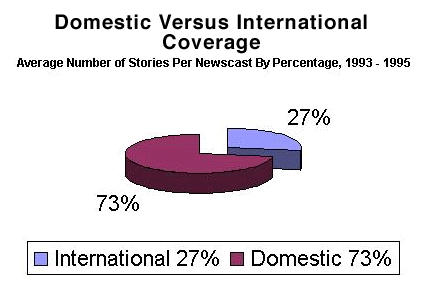
|
Figure 7
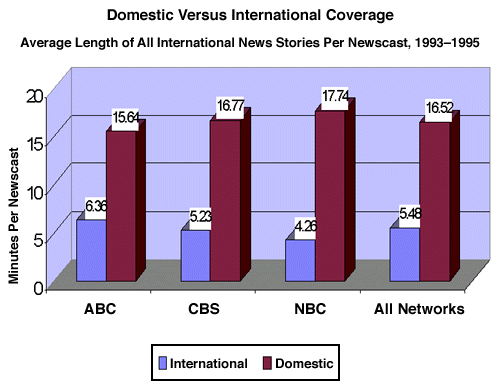
|
There is little difference between the networks in terms of the average number of international news stories per nightly newscast, just over three international news stories per nightly newscast, or 27 percent of the evening’s broadcast.
|
Table 3: Average Number & (Percentage) of International Stories Per Network Broadcast 1993 – 1995
|
As illustrated in table 3, ABC averaged just under three-and-a-half (3.41) international news stories per broadcast, while CBS and NBC averaged 3.19 and 2.60, respectively.
In Larson’s 1984 study, there was an average of seventeen news stories per broadcast per night. Of the seventeen stories, approximately seven (or 41 percent) dealt with international affairs (1984, p. 40). Juxtaposed this with our results and we see a 14 percent decline in the number of international stories included in a newscast.
Fluctuations obviously exist in the number of international news stories covered on the evening news programs. Figure 8 uses the results of past studies (Gonzenbach, Arant and Stevenson, 1992; Norris, 1995) to demonstrate the fluctuations in the number of international news stories on the evening newscasts from 1972 to 1992.
Figure 8
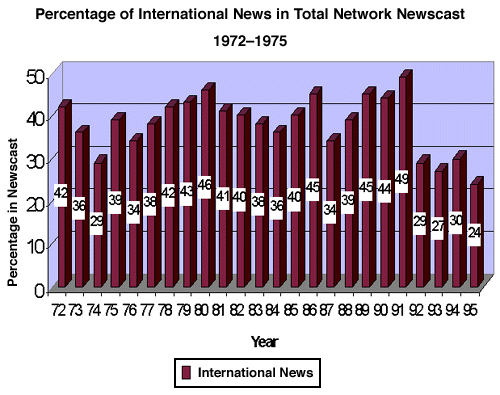
|
This graph captures media attention to several of the historic events of each period: Vietnam from 1972 to 1975, the Iranian hostage crisis in 1979–80, the bloodshed in Central America and the controversy it generated in the United States in the 1980s, the collapse of Communism, and the Persian Gulf War in 1990–91.
Figure 9 juxtaposes Larson’s (1984) results with the results of this study. The more darkly shaded area on the column on the right — international news content — is only about half the proportion found by Larson in news between 1972 and 1981. This is a decrease of over 20 percent.
Figure 9
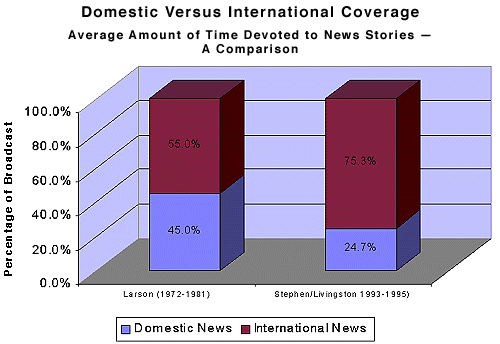
|
Crisis is a constant theme of television news. 8 Table 4 indicates the percentage of stories devoted to crisis themes for 1993 – 1995.
|
Table 4: Average Percentage of International Stories Devoted to Crisis Themes
|
|||||||||||||||||||||||||||||||||||
Larson found that, for international stories analyzed from 1972 to 1981, 27 percent dealt with crisis themes (1984 p. 146). By the 1990s, crises constituted well over half the news content. The approximate thirty percent increase in crisis-related international stories is dramatic.
More than ever, international affairs is covered by “parachute journalists” who travel from crisis to crisis (Norris 1995 p. 368). In unfamiliar political circumstances such as Rwanda, they are left to rely on bromides like “ancient ethnic hatreds” to explain conflict. More familiar story lines such as fighting disease are relied on, too.
Larson (1984, p. 55) found that the top five most frequently mentioned nations by all networks were the USSR, Israel, Great Britain, South Vietnam, and Iran. This has changed considerably. Our study concluded that Eastern Europe, averaging about 30 percent of the coverage, was the most covered region. Most of the attention was devoted to Bosnia and Russia.
|
Table 5: Geographic Focus: Average Percentage Of Stories Per Geographic Region 1993 – 1995
1993, 322; 1994, 390; 1995, 300. Percentages based on these totals. |
Increasing in coverage from .09 percent in 1993 to 19 percent in 1994, was Latin America/Caribbean. This resulted from the United States’ assistance in restoring democracy to Haiti. Turmoil in Mexican politics and reporting of events in Cuba also contributed to coverage of Latin America/Caribbean.
It is also important to recognize that there was a significant decrease in the amount of coverage devoted to Africa from 1993 to 1995. Attention to that region deceased from a high of 14 percent in 1993, mainly concerning Somalia, to a low of .05 percent in 1995. This was at a time when one to two million Rwandan refugees sat in refugee camps in or around Rwanda. Yet, after American soldiers departed Somalia, events in Africa disappeared from American television screens.
The American experience in Somalia in 1992–93 left a clear impression on the public, political and military leaders, and the press. After so much bloodshed, including American blood, there was a reluctance to either become politically or emotionally involved in Rwanda the following year. In this dynamic, though, the reluctance of American officials was most important. As the data presented above suggest, the news media typically use the presence of Americans or expressions of official American interests as catalyst for their involvement in a story. News organizations follow official leads in foreign affairs news (Livingston and Eachus 1995).
Summary
The pattern of American network news coverage of Rwanda was not an aberration. In fact, coverage of Rwanda helped define the character of post-Cold War news coverage of international events. The networks turned away from international affairs in favor of O.J. Simpson, and the other characters in the constant stream of scandal and sensationalism that has come to characterize television news in the 1990s. The networks concluded that following the experience of Somalia in October 1993, Americans were no longer interested in another African crisis, this time in Rwanda. In fact, the networks concluded Americans were not interested in foreign affairs, period.
The expense in covering international affairs and the difficulty found in finding new ways to quickly tell complicated events in distant places also contributed to the tendency to turn away from international news. In their earlier studies, Hess and Larson found that international news most often contained an American connection. International news was also news about the United States. There was also an overlapping but unifying ideological frame of reference. What might otherwise appear to be disparate places and events were rhetorical unified by the fight against Communist aggression. From Angola to Nicaragua, the rubric of “American-backed” verses “Soviet-backed” offered a compelling and efficient way of telling stories about complicated political realities. History, culture, and what might be thought of as “on the ground realities” — poverty, corruption, brutality — often were pushed aside by the enduring wedge of the Cold War news frame.
Rwanda was different. It was in and of itself compelling — the massacre of so many could not be ignored. But it could not be easily explained. No shorthand news frame was available. Instead, we were given correspondents such as Dr. Bob Arnot of CBS news who told us about the fight against disease rather than the fight between the Hutu and Tutsi. This was the nature of American network news coverage of Rwanda.
References
Adams, William C. 1982. Television Coverage of International Affairs. Norwood, New Jersey: Ablex Publishing Corporation.
Almaney, Adnan. 1960. “International and Foreign Affairs on Network Television News.” Journal of Broadcasting. 14: 499–509.
Atwater, Tony and Norma F. Green. 1988. “News Sources in Network Coverage of International Terrorism.” Journalism Quarterly, 65:967–971.
Gallup Organization Poll. 1989. “Public Opinion and the Press.” Gallup Organization (August 1989).
Gonzenbach, William J., M.David Arant, and Robert L. Stevenson. 1992. “The World of U.S. Network Television News: Eighteen Years of International and Foreign News Coverage.” Gazette, 50:53–72.
Hachten, William A. 1996. The World News Prism: Changing Media of International Communication. Ames, Iowa: Iowa State University Press.
Hallin, Daniel C. 1994. We Keep America on Top of the World. New York: Routledge.
Hess, Stephen. 1996. International News and Foreign Correspondents. Washington, D.C.: The Brookings Institution.
Hester, Al. 1978. “Five Years of Foreign News on U.S. Television Evening Newscasts.” Gazette. 24:86–95.
Kitagawa, Yukiyo, ichael B. Salwen, and Paul D. Driscoll. 1994. “International News on Japanese and American Network Television: Regionalism and Conflict.” Gazette. 54:87–93.
Larson, James F. and Andy Hardy. 1977. “Internatioinal Affairs Coverage on Network Television News: A Study of News Flow.” Gazette. 4:241–256.
Larson, James F. 1982. “International Affairs Coverage on U.S. Evening Network News, 1972 – 1979.” In William C. Adams, ed., Television Coverage of International Affairs. Norwood, New Jersey: Ablex Publishing Corporation. P. 15–41.
Larson, James F. 1984. Television’s Window on the World: International Affairs Coverage on the U.S. Networks. Norwood, New Jersey: Ablex Publishing Corporation.
Livingston, Steven and Todd Eachus. 1995. “Humanitarian Crises and U.S. Foreign Policy: Somalia and the CNN Effect Reconsidered,” Political Communication, Winter 1995.
________. 1998 forthcoming. “Media Coverage of U.S. Foreign Policy,” in The Path of a Genocide: the Rwanda Crises from Uganda to Zaire, Adelman and Suhrke (eds). Trenton, New Jersey: Transaction Books.
Lorch, Donatella. April 24,1995. “As Many as 2,000 Are Reported Dead in Rwanda,” The New York Times.
Manheim, Jarol B. and Richard C. Rich. 1995. Empirical Political Analysis: Research Methods in Political Science. White Plains, New York: Longman Publishers USA.
Mickiewicz, Ellen. 1988. Split Signals: Television and Politics in the Soviet Union. Newbury Park, California: Sage Publications.
Norris, Pippa. 1995. “The Restless Searchlight: Network News Framing of the Post-Cold War World.” Political Communication. 12:357–370.
Parker, Richard. 1995. Mixed Signals: The Prospects for Global Television News. New York, New York: Twentieth Century Fund Press.
The Pew Research Center For The People & The Press. 1996. “TV News Viewership Declines.” The Pews Research Center For The People & The Press News Release (May 13, 1996). P. 14.
Reuven, Frank. 1993. “Localizing Network News.” New Leader. 76:20–21.
Rosenblum, Mort. 1993. Who Stole the News: Why We Can’t Keep Up With What Happens in the World and What We Can Do About It. Toronto: John Wiley & Sons, Inc
Sparkes, Verone M. and James P. Winter. 1980. “Public Interest in Foreign News.” Gazette. 26:149–170.
Times Mirror Center for the People and the Press. 1994. “Eight Nation People and the Press Survey Mixed Message about Press Freedom on Both Sides of the Atlantic.” Times Mirror Center for the People and the Press News Release (March 16, 1994). P. 19.
Vanderbilt Television News Archive. “1993 Evening News Abstracts.” http://tvnews.vanderbilt.edu/1993a.html. October 1996.
Vanderbilt Television News Archive. “1994 Evening News Abstracts.” http://tvnews.vanderbilt.edu/1994a.html. October 1996.
Vanderbilt Television News Archive. “1995 Evening News Abstracts.” http://tvnews.vanderbilt.edu/1995a.html. October 1996.
Wallis, Roger and Stanley J. Baran. 1990. The Known World of Broadcast News: International News and the Electronic Media. New York, New York: Routledge.
Weaver, James, Christopher Porter and Margaret Evans. 1984. “Patterns in Foreign News Coverage on U.S. Network Television: A Ten-Year Analysis.” Journalism Quarterly. 61:356–363.
Endotes
Note 1: Figures 1–5 were created with the assistance of Todd Eachus. Back.
Note 2: A quick count finds that in one year, 1985, the New York Times referred to “American-backed” rebels, government or guerrillas 43 times. It used the phrase “Soviet-backed” rebels, government, or guerrillas 48 times. In 1994, the year of the Rwandan genocide, the New York Times used “American-backed” to modify references to various nouns 29 times. Except for one reference to Kuwaiti troops and seven references to various governments or rebel organizations of the 1980s, all were assigned as a modifier of the term “Bosnian peace plan.” In short, with the end of the Cold War reporters were left without the benefit of a quick news frame that in a matter of a sentence or two could leave the impression of understanding. Back.
Note 3: Larson’s total sample included an average of three week night newscasts per month for each network over the 1972 – 1979 period; in other words, over 13% of all week night broadcasts over the eight years were sampled for the content analysis. The total sample contained 286 newscasts for NBC, and 288 for both ABC and CBS. The total number of international news stories found in these sample programs ranged from 1,789 on ABC to 1,884 on CBS. The study is based on quantitative measure from Vanderbilt University’s Television News Index and Abstracts. Back.
Note 4: Larson analyzed network newscasts from 1972 – 1981. The total sample included more than 1,000 newscasts, or approximately 13 percent of all weeknight news broadcasts for each network during the ten years. This amounted to 7,054 international news stories, more than 2,000 for each of the three major networks. The study is based on quantitative measures from Vanderbilt University’s Television News Index and Abstracts. In this study, as in Larson’s previous studies (Larson and Hardy 1977 and Larson 1982), international news is defined as, “Any news story that mentions a country other than the United States, regardless of its thematic content or dateline, is considered an international news story (Larson 1984 p. 36).” Back.
Note 5: he proportion of references by region for the three broadcast networks were in order Western Europe, 30.7 percent; the Middle East, 29.3 percent; Asia, 28.1 percent; Eastern Europe (including the USSR), 20.2 percent; Latin America, 11.1 percent Africa, 7.2 percent; and Canada, 2.3 percent. Back.
Note 6: A sample was drawn from broadcasts on a constant day (every Monday) during one constant month per annum (February) (Norris 1995 p. 360–361). As with previous studies, this inquiry utilized the Vanderbilt Television News Index and Abstracts. Back.
Note 7: Hess used the Vanderbilt Television News Index and Abstracts for data on the three major networks. He defines international news as “any story in which a foreign country is mentioned” (1996 p. 7). Back.
Note 8: This study utilized the Larson’s 1984 coding scheme for measuring the thematic content of international news content. Crisis topics included stories categorized by 1) unrest and dissent, 2) war, terrorism, crime, 3) coups and assassinations, and 4) natural and man-caused disasters. Non-crisis subjects included 1) political and military affairs, 2) economics and trade, 3) environment, 4) technology and science, and 5) human interest. Back.